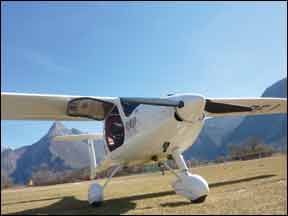Little white LSAs seem to flow from eastern Europe in such a steady trickle that we’ll admit to thinking that one is mostly like another. Indeed, a peek under the cowl reveals the same engine (a Rotax 912) that yields unsurprisingly similar performance. But one that’s a standout, at least in speed, in a undistinguished field is Pipistrel’s Virus SW.
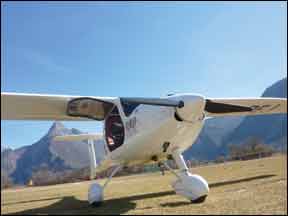
Pipistrel has gained some note for having run away with the NASA Green Flight Challenge three times with various iterations of its product line, including a purpose-made variant of its Taurus motorglider. All of the Pipistrel airplanes are unique for having evolved from gliders, so they have slender, exceptionally light fuselages, high aspect-ratio wing planforms and low drag.
Currently, there are five powered airplanes in the line, the Sinus 912, the Virus 912 and SW, which is a shorter wing version of the 912 and two versions of the mid-wing Taurus motorglider, one powered by a Rotax 503 and another by an electric motor with a rechargeable battery pack.
U.S. Presence
Although it’s gained a higher profile through the NASA challenges, Pipistrel hasn’t enjoyed wide sales success in the U.S. According to Ivo Boscarol, the company’s voluble and energetic founder, this is because Slovenia, where the aircraft are manufactured, lost its bilateral export agreements with the U.S. when the former Yugoslavia dissolved in 1991. Although the European Union countries do have these agreements, Slovenia joined the EU after they were negotiated, leaving the country—and Pipistrel—in a regulatory no-man’s land.
“We will address this by opening a factory in Italy,” Boscarol told us. For now, the airplanes are manufactured in Ajdovscina, Slovenia, about 20 miles northeast of the Italian city of Trieste. The new factory is expected to be operating sometime in 2015. In the meantime, it is possible to buy a Pipistrel through a third-party arrangement handled through Australia. Contact Pipistrel USA at www.pipistrel-usa.com or 213-984-1237 for the details.
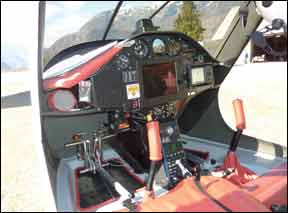
Boscarol told us that Pipistrel benefits from being located in a country with a long tradition of composite glider manufacture. As a result, it’s horizontally integrated, doing all of its design and prototyping in house but relying on out-of-house vendors for major components, especially composite assemblies.
Final assembly and test flight is done at the factory, which is located at an expansive grass field on the edge of Ajdovscina. When we visited in early March, Pipistrel was finishing up installation details and about to fly the Virus SW with Rotax’s new 912iS.
And by the way, the airplane’s name derives not from some obscure Slovenian word that the company didn’t realize had an unintended translation. It’s quite intentional and a bit of an inside joke. When it began to find success with its airplanes, the Pipistrel staff would joke that would-be customers came back enthusiastically impressed after test flights and had thus caught the Pipistrel virus. The name stuck.
Very LSA
Pipistrel aircraft are manufactured to the 600 kilo or 1320-pound light sport standard but are light enough to also qualify under the 475 kilo (1045 pounds) European ultralight standard. As a result, the empty weights of these models are among the lightest we’ve seen. The version we flew, which was moderately equipped in the European sport style, weighed 655 pounds empty for a useful load of 390 pounds. Under the U.S. limit, useful load would rise to 665 pounds, so yes, it’s capable of lifting its own empty weight.
Pipistrel achieves this light weight because it builds its airplanes like gliders. The composite work is no thicker than it needs to be to carry the load and at every turn, components are small and lightened by material removal. Boscarol said Pipistrel counts its weight budget in grams and we can believe it.
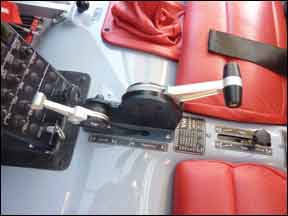
When we poked our head into the cockpit, the first thing we thought of was Paul MacCready’s Gossamer airplanes. Obviously, the Virus SW isn’t quite that light, but it clearly has the feel of being ultra-efficient and minimal with structure. Although the wingspan, at 35.3 feet (10.7 meters) is longish, the cockpit itself is narrow and somewhat short from the seatbacks to the panel. The seats are of the lightest foam material—slings, really—whose rake is adjusted with a pair of straps behind each seat. The baggage compartment is accessible by prying loose some Velcro at the top of the seats and folding the seatbacks forward. Given the airplane’s tiny size, these aren’t easily accessible in the air, so if you need it during flight, you’d better have it out. The glareshield has some room for charts and maybe a tablet, but is actually a long reach from the seats. It could benefit from a tray or some other fixture to hold stuff. The doors are clear plastic and hinge upward, with clips to hold them up for ingress and egress.
As is obvious from the photos, the panel is not large, but is big enough for typical LSA avionics, say a Dynon 180 or Skyview. The Garmin 696 would fit, along with a radio of some sort. Operating under European ultralight rules, the Virus can have a bewildering array of options including something we can’t have in the U.S.—a controllable pitch prop. The version we flew had an electrically controllable constant speed prop with a knob to set the RPM, a novel solution.
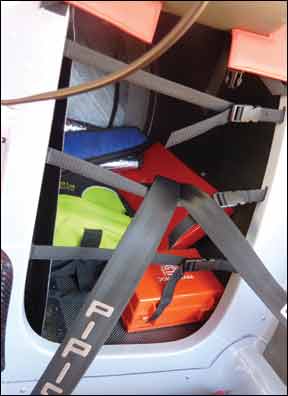
Rather than conventional ailerons, the Virus has full- span flaperons with two positive settings (9 and 18 degrees) plus one negative setting at 5 degrees. It also has manually deployable spoilers, just as on a glider, but rather than being in the cockpit sidewall, the spoiler control is on the ceiling between the two pilots. Flaperon circuitry is via rods, the elevator and rudder use cables. The rudder pedals are quite small and light, with toe brakes. Although the seats are fixed, the pedals can be repositioned fore and aft.
By the time the Rotax 912iS is shipping, the Virus SW will be available with three powerplant choices—the 80- or 100-HP Rotax 912 and the new 912 iS. Given the airplane’s low drag, 80 HP wouldn’t be too little power.
After examining the Virus airframe and eyeballing it head on, one thing is clear: The airplane has small frontal area and that’s partly how it manages its speed on such low horsepower. And small frontal area means a smallish cockpit and that the Virus has. Getting into it requires a butt-first insertion, following by swinging the legs over the stick into the rudder well. The stick is short enough so that this turns out to be easy. But the door height is limited, so you have to duck in to clear your head. Once in, the seat position is slightly reclined and it’s a surprisingly long reach to the glareshield. In fact, you can’t reach it if you’ve got the shoulder harness snugged down. And flying in the Slovenian mountains with a turbulent burya blowing, snug is advisable.
The Virus’s 912 requires the usual Rotax warm-up, but in the model we flew with Pipsitrel’s Nejc Faganelj—equipped with an electric constant speed prop—you also have to set it to max RPM for takeoff, which is 5800. The takeoff roll is brisk and the initial climb rate is robust, given the light airframe and relatively high power-to-weight ratio. The low drag doesn’t help much in climb, but the light weight does. When you level out in cruise, the airplane seems to leap forward all at once.
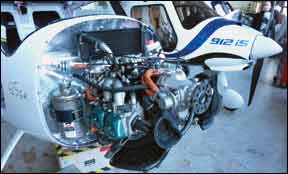
Lots of speed
As with all LSAs, the control forces are light, except in roll, which is a little heavier than we’re used to. Those full-span flaperons catch a lot of air, but they don’t have much deflection so roll isn’t as quick as you might expect and the long wings seem to have noticeable inertia. Pitch is very light, but predictable, so we wouldn’t call it twitchy. As it should, the pitch force gradient increases with control travel. Slow flight is different. The airplane is so slick that you can idle the engine and have cappuccino and biscotti while you wait for it to slow down.
Once in slow flight, there’s not much objectionable adverse yaw to deal with; you can practically fly it feet on the floor. In the stall regime, it will do the usual LSA parachute mode, bobbling along in a high sink rate and not threatening a spin entry unless aggravated. Its spiral stability—the tendency to right itself to wings level in a hands-off banked turn—is quite positive. An excited phugoid seemed to damp back to the trimmed airspeed in less than a cycle, but given the turbulence, we couldn’t judge it accurately.
Cruise flight is something else. When the airplane gets going, it sounds fast. The slipstream rushes past those clear plastic doors like you’re going 150 knots. And we were close to it. With the Rotax at about 70 percent power, we saw about 270 KPH indicated, or about 142 knots. Faganelj told us the fuel flow indicator in the airplane was reading too high so with no other confirmation, we couldn’t confirm it. Ivo Boscarol says the airplane burns around 3.2 to 3.5 GPH at that power setting and speed and we’ll accept that as a fair gauge. It works out to an impressive 40 to 44 NMPG, depending on where you want to put the throttle.
In normal cruise, the flaperons have a -5 degree position, which has the effect of reducing down force on the tailplane and sharply reducing induced drag enough to add several knots to the top cruise speed. Or, you can slide the power back and get just stupid range out of the thing, considering that with 26 gallons aboard, (100 liters) the endurance can be an easy bladder-busting 8 hours. Also back busting. The seats are, unfortunately, not terribly comfortable, in our view. We didn’t have time to try the adjustable straps to change the seating position and that might help. Otherwise, two or three hours in the airplane would be plenty, thanks. If we owned the airplane, we would try to do some custom foam pads of some sort.
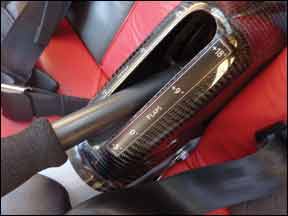
Throttled back, it’s possible to lower the fuel flow to around 2.5 GPH at a speed of 120 to 125 knots or so. That’s 10 hours and easily 1000 miles of still-air range. No wonder the Virus’s stablemate Sinus airframe holds several long distance records and owners of both airplanes are flying them across major bodies of water as a matter of course.
“This is becoming quite a nice little niche for us,” Ivo Boscarol told us. The company has sold about a dozen models that carry up to 250 liters—65 gallons—of fuel for an honest range of 2000 miles. With the new Rotax 912iS and its claimed 20 percent better fuel efficiency, it’s possible to imagine one of these airplanes flying non-stop coast-to-coast in the U.S. for $350 in fuel. It might not be luxurious, but doable and luxurious aren’t always the same thing.
Flaps and Spoilers
Of course, there’s always a second shoe to drop when an airplane goes this fast on so little fuel and it’s this: This puppy doesn’t want to slow down and come down, either separately or at the same time. Viewed in the pattern from the ground, you can’t help but wonder…what the hell is that fast little thing? From inside the cockpit, a typical approach speed of 60 knots (100 KPH) is nothing out of the ordinary for an LSA, but the Virus’s glider-like approach profile is flat and if you’re not tending to business, this airplane will float down the runway into the next zip code. When it hits ground effect, it skids along like an air hockey puck. So to keep it manageable, you set a drag value with full flaperons—and that’s not much drag—and dirty the thing up more with the top-wing spoilers. The preferred method seems to be to set the power at idle with flaperons full down, then modulate the spoilers to adjust the approach angle. A glider-experienced pilot will feel right at home, save for the fact that the spoiler lever is on the roof instead of the cockpit sidewall.
With just flaperons and no spoilers, the approach is so flat as to be almost alarming. And with neither flaps nor spoilers, you have to be prepared to bleed off speed in ground effect for hundreds of feet, then touch down fast and use the wheel brakes to get it stopped.
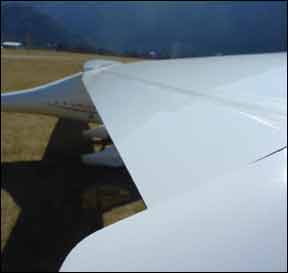
The Virus will eat up a lot of runway doing that. It’s a fun challenge to fly, but still a challenge. If all that’s still a little too boring, you can order the airplane in a taildragger version, too, which has even less drag and, says Taya Boscarol, is also 8 knots faster in cruise.Pipistrel is also developing a trainer version of the Virus called the Alpha Trainer. It will have beefed-up landing gear and other features aimed the training market and will be available later this year.
Conclusion
What to make of this thing? At typically equipped prices of $120,000 to $130,000, it’s in the mid-price range as far as LSAs go. (The Alpha Trainer will sell for about $82,000 base.) You can spend more and get less performance.
This airplane reminds us of exotic super cars. Fast, nimble, nice to look at, but not high on comfort or luxury. For pilots who derive satisfaction out of squeezing the most knots out of a gallon of gas and actually being able to fly long trips on what amounts to pocket change, the Virus SW is worth considering.
But it’ll take a certain mindset. If you could do a week on a motorcycle with your significant other and carry the stuff you need in a pair of saddlebags, you’ll be nonplussed by the Virus’s cozy cockpit and baggage area. There’s room enough to make it work with a little organization. Otherwise, better think about FedExing the luggage.

